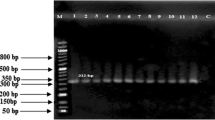Abstract
The present study was conducted to screen Kashmir valley sheep with history of prolificacy for the presence of FecB mutation. Forced polymerase chain reaction–restriction fragment length polymorphism (PCR–RFLP) and single strand conformation polymorphism (SSCP) techniques were employed to detect any polymorphism present in bone morphogenetic protein receptor type 1B (BMPR1B) gene. Further, it was aimed at introgressing the FecB mutation into nonprolific noncarrier sheep. A 140-bp fragment of BMPR1B gene was amplified from isolated genomic DNA and subjected to forced RFLP with restriction enzyme AvaII. Three different RFLP patterns were identified. SSCP analysis showed one-to-one correspondence with RFLP patterns. Sequencing of the samples showing different patterns revealed that the wild (+) and mutant (B) alleles were different by a single nucleotide substitution in the form of A109G from wild to mutant allele. It led to change in amino acid from Glutamine (Q) to Arginine (R) from wild to mutant allele. The mutation was only detected in NARI-Suwarna and their crosses; all Kashmir valley sheep with prolific history lacked it. The + allele was abundant in the studied population. The FecB mutation was introgressed in nonprolific noncarrier sheep by crossing ewes with NARI-Suwarna rams possessing the mutation. First generation crossing produced heterozygous (B+) progeny. Some of the F1 heterozygous ewes gave birth to twins when mated to unrelated NARI-Suwarna rams. It showed that FecB mutation was successfully expressing in those crosses.



Similar content being viewed by others
References
Bassam, J.B., Gustavo, C.A. and Peter, M.G., 1991. Fast and sensitive silver staining of DNA in polyacrylamide gel, Analytical Biochemistry, 196, 80–83.
Davis, G.H., Balakrishnan, L., Ross, I.K., Wilson, T., Galloway, S.M., Lumsden, B.M., Hanrahan, J.P., Mullen, M., Mao, X.Z., Wang, G.L., Zhao, Z.S., Zeng, Y.Q., Robinson, J.J., Mavrogenis, A.P., Papachristoforou, C., Peter, C., Baumung, R., Cardyn, P., Boujenane, I., Cockett, N.E., Eythorsdottir, E., Arranz, J.J., Notter, D.R., 2006. Investigation of the Booroola (FecB) and Inverdale (FecXI) mutations in 21 prolific breeds and strains of sheep sampled in 13 countries, Animal Reproduction Science, 92, 87–96.
Falconer, D.S. and Mackay, T.F.C., 1998. Introduction to Quantitative Genetics 4th ed. (Addison Wesley Longman Ltd., Essex, England)
Fogarty, N.M., 2009. A review of the effects of the Booroola gene (FecB) on sheep production, Small Ruminant Research, 85, 75–84
Gootwine, E., Rozov, A., Bor, A. and Reicher, S., 2006. Carrying the FecB (Booroola) mutation is associated with lower birth weight and slower post-weaning growth rate for lambs, as well as a lighter mature bodyweight for ewes, Reproduction, Fertility and Development, 18, 433–437.
Guan, F., Liu, S.R., Shi, G.Q. and Yang, L.G., 2007. Polymorphism of FecB gene in nine sheep breeds or strains and its effects on litter size, lamb growth and development, Animal Reproduction Science, 99, 44–52
Hua, G.H., Yang, L.G., 2009. A review of research progress of FecB gene in Chinese breeds of sheep, Animal Reproduction Science, 116, 1–9.
Kumar, S., Kolte, A.P., Mishra, A.K., Arora, A.L. and Singh, V.K., 2006. Identification of FecB mutation in Garole × Malpura sheep and its effect on litter size, Small Ruminant Research, 64, 305–310.
Kumar, S., Mishra, A.K., Kolte, A.P., Arora, A.L., Singh, D. and Singh, V.K., 2008a. Effects of the Booroola (FecB) genotypes on growth performance, ewe’s productivity efficiency and litter size in Garole × Malpura sheep, Animal Reproduction Science, 105, 319–331.
Kumar, S., Mishra, A.K., Kolte, A.P., Dash, S.K. and Karim, S.A., 2008b. Screening for Booroola (FecB) and Galway (FecXG) mutations in Indian sheep, Small Ruminant Research, 80, 57–61.
Nimbkar, C., Ghalsasi, P.M., Nimbkar, B.V., Walkden-Brown, S.W., Maddox, J.F., Gupta, V.S., Pardeshi, V.C., Ghalsasi, P. and van der Werf, J.H.J., 2007. Reproductive performance of Indian crossbred Deccani ewes carrying the FecB mutation. In: Proceedings of Association for the Advancement of Animal Breeding and Genetics, 17, 430–433.
Polley, S., De, S., Brahma, B., Mukherjee, A., Vinesh, P.V., Batabyal, S., Arora, J.S., Pan, S., Samanta, A.K., Datta, T.K. and Goswami, S.L., 2010. Polymorphism of BMPR1B, BMP15 and GDF9 fecundity genes in prolific Garole sheep, Tropical Animal Health and Production, 42, 985–993.
Sambrook, J., and Russell, D., 2001. Molecular Cloning. A Laboratory Manual 3 rd ed. (Cold Spring Harbor Laboratory Press, Cold Spring Harbor, N.Y.)
Shi, H., Bai, J., Niu, Z., Muniresha, Fen, L. and Jia, B., 2010. Study on candidate gene for fecundity traits in Xingjiang Cele black sheep, African Journal of Biotechnology, 9, 8498–8505
Wilson, T., Wu, X.Y., Juengel, J.L., Ross, I.K., Lumsden, J.M., Lord, E.A., Dodds, K.G., Walling, G.A., McEwan, J.C., O’Connell, A.R., McNatty, K.P. and Montgomery, G.W., 2001. Highly prolific Booroola sheep have a mutation in the intracellular kinase domain of bone morphogenetic protein 1B receptor (ALK-6) that is expressed in both oocytes and granulosa cells, Biology of Reproduction, 64, 1225–1235.
Acknowledgements
The authors are thankful to the Department of Biotechnology (DBT), Government of India for providing financial assistance for conducting the study. Thanks are also due to the local farmers who allowed collection of blood samples from their sheep.
Author information
Authors and Affiliations
Corresponding author
Rights and permissions
About this article
Cite this article
Ganai, T.A.S., Misra, S.S. & Shabir, M. Polymorphism analysis of BMPR1B gene by forced RFLP and PCR-SSCP techniques and expression of the mutation in introgressed sheep. Trop Anim Health Prod 44, 277–283 (2012). https://doi.org/10.1007/s11250-011-0015-y
Accepted:
Published:
Issue Date:
DOI: https://doi.org/10.1007/s11250-011-0015-y




